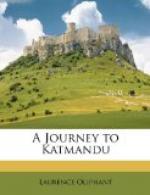The sights at Delhi are worth a visit, but are too well known to need description. In the centre of the town stands the Jumma Musjid, the St. Peter’s of Mahomedans; its handsome domes and tapering minarets are built of red sandstone and white marble, a combination which is common in the edifices of this city, and which produces a most agreeable effect. From the summit of one of the minarets an extensive view is obtained.
The large and well-built city, containing 156,000 inhabitants, is enclosed by a wall, beyond which the country stretches away in appearance much like the Campagna at Rome. It is covered with ruins, which, with a few modern tombs scattered amongst prostrate slabs, give it a picturesque aspect. Through this Campagna we drove one day to see the Coutub. We passed the handsome tomb of Suftur Jung, and the mausoleums of many other worthies, the splendour of whose present resting-places betokened their former greatness. The Coutub is a tall column that is said to have been originally intended for a minaret, though the Hindoos claim it as having been erected before the Mahomedan invasion; however that may be, it is a singularly beautiful monument, and rises to a height of 260 feet. It was worth toiling up its narrow circular staircase to enjoy the view which the summit afforded of the country I had just traversed: the Jumma Musjid at Delhi was discernible in the distance, while immediately below lay the large camp of the Commander-in-Chief, the tents of which were pitched with great regularity, and looked dazzling white in the bright sun. After descending the column, I wandered awhile amidst the ruins at its foot, some of which looked very much as if they were of Jain origin,—and then returned to a desirable tomb, which the hospitable commissioner has converted into a delightful retreat from the noisy city.
I left Delhi with no little regret after an agreeable sojourn of a week, and rolled rapidly over the excellent road to Agra, so smooth that it was irresistible to the laziest horse, and 130 miles were easily accomplished in eighteen hours including stoppages.
Of Agra the passing traveller can say little, because its wonders are so inexhaustible and so interesting. The magnificent tomb at Secundra of that greatest of Mahomedan princes, Ackbar, must be left to the description already given by travellers of more leisure; so must the fort and the white marble palace which it contains, where dwelt the powerful Aurungzebe when he made Agra his capital. It was an endless source of interest to me to wander through the paved courts and under the marble columns of that glistening palace,—to look down upon the river, winding at the base of the lofty walls,—to descend into dark vaults in which were fountains and baths with water ever cool,—to creep yet lower, with a dim flickering light, into the execution chamber, and stand under the beam which had sustained the fair form of many a frail and faithless beauty,—to retreat from the stifling influence of its confined air, and return to inspect delicate little mosques, in which the Queen and her maidens used to perform their devotions, and which were as pure and chaste as the ladies were supposed to be.




